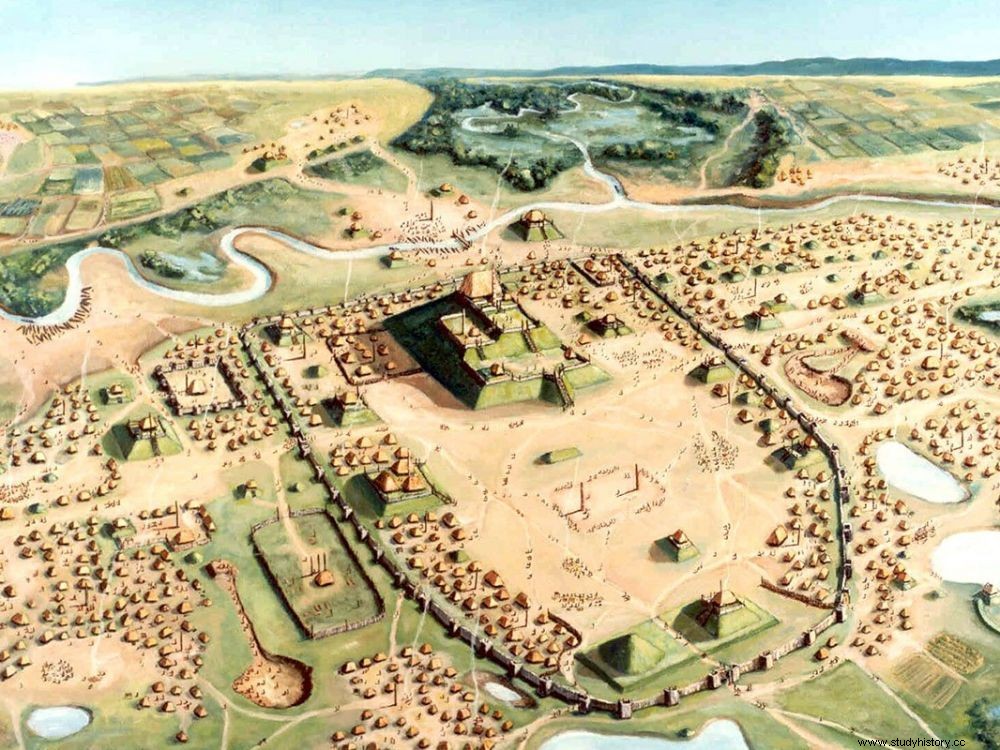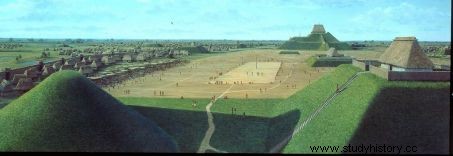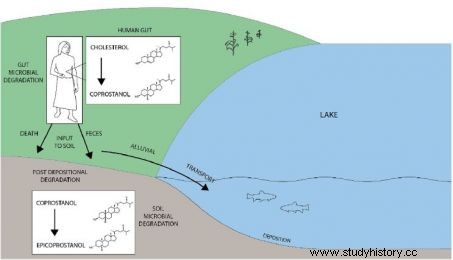Walking in it would bring good luck...but not only that! US scientists have used biomarkers from human and animal feces to better estimate the occupation and decline of the pre-Columbian site of Cahokia, North America.

The site of Cahokia, one of the largest Amerindian cities in North America at the time of its apogee, in the twelfth th century.
"Everyone has always pooped, and using faecal stanols to measure and track the demographics of a population is one avenue of research promising" , explains A.J. White, an anthropologist at the University of California (Berkeley).. According to the specialist, joined by Sciences et Avenir , coprostanol – a compound resulting from the degradation of cholesterol present in human stools – can indeed be preserved for centuries in archaeological soils and thus be quantified. It is this method that he applied to better understand the settlement of Cahokia, an archaeological site near the current city of Saint-Louis in Illinois, as he describes in an article published by the journal Journal of Archaeological Science. This large Native American city, located at the confluence of the Illinois, Missouri and Mississippi rivers, was mostly occupied between 1050 and 1350 CE, and is best known for its spectacular complex of earthen structures.
A city contemporary with those of the Mayas or the Aztecs
In fact, there were not only teepees in the plains of the North American continent. East of the Mississippi, imposing constructions were also erected for centuries by a culture called the "Mound Builders", largely unknown to the public and which extended from the Great Lakes to in the Gulf of Mexico between 800 and 1550. Some of these "effigy tumuli", with extraordinary architectures, are still visible in the landscape like the "Great Serpent", in Ohio, and its 400m long or that "of the Monks". Cahokia (a World Heritage Site since 1982) was arguably the first - and largest - city in North America, where hundreds of mounds and vast platforms hosted buildings and villages. With its central square, the city shared many points in common with those, contemporary, of the Mayas or Aztecs in Central and South America.
 Located east of present-day St. Louis, the site of Cahokia was surrounded by a 3km long palisade, and included a large central square, numerous community buildings and imposing tumuli. © Painting by Lloyd K. Townsend. Courtesy of the Cahokia Mounds State Historic Site, Illinois.
Located east of present-day St. Louis, the site of Cahokia was surrounded by a 3km long palisade, and included a large central square, numerous community buildings and imposing tumuli. © Painting by Lloyd K. Townsend. Courtesy of the Cahokia Mounds State Historic Site, Illinois.
After raising tumuli for centuries, the Mississippians suddenly abandoned them around 1500. For what reasons? Among the explanations put forward - which give rise to bitter discussions - is that of a crisis due to serious environmental problems. These immense embankments of several hundred meters in extension, mostly concentrated along the major river basins (Tennessee, Cumberland, Mississippi), could have been victims of destructive floods. It is thus to better understand the origin of the demographic decline of the city of Cahokia that the Californian researchers were interested in the faecal stanols of human and animal origin * preserved in the cores of lake sediments taken from Lake Horseshoe, bordering the cited.
 Schematic illustrating the formation, deposition, and degradation of human fecal stanols. © A.J. White, Department of Geological Sciences, California State University.
Schematic illustrating the formation, deposition, and degradation of human fecal stanols. © A.J. White, Department of Geological Sciences, California State University.
Following the analysis of a large number of samples, the Californian experts were able to establish that a peak in population, attested by high concentrations of stanols in the soil, would have taken place in the 12th e century. The city would then have had up to 20,000 inhabitants. But these components then appear to gradually decline to 1400, suggesting that the environmental stressors spotted as early as the mid-12th th century played a major role in the decline of the city:floods from the Mississippi River and a succession of droughts unfavorable to the intensive cultivation of corn (the dominant food along with beans and squash) could have started to occur as early as 1150 .
Similar studies based on the analysis of stanols have already been successfully carried out in Norway. Others are currently underway in Peru, led by a team from the University of Pittsburgh (United States). This time, around the basin of Lake Titicaca…
*Apart from humans, other mammals such as dogs, donkeys, horses, and cattle also produce coprostanol. However, only sheep and pigs are known to generate significant amounts that can mask concentrations of human origin. In Cahokia, there were no pigs or sheep.
